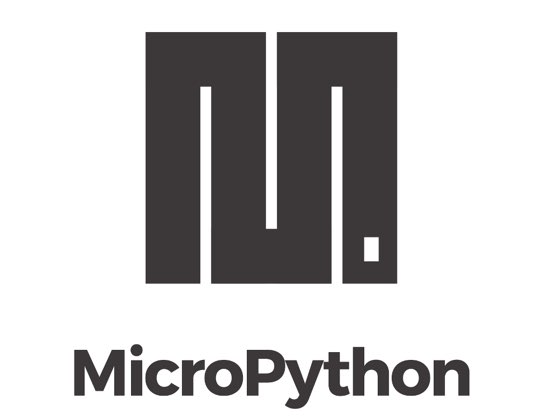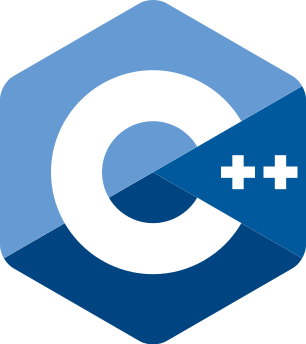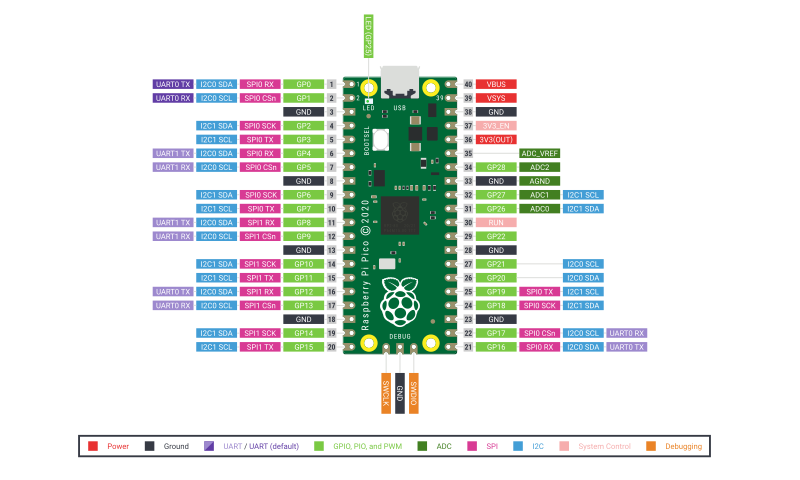




zł26.75 tax excl.
Raspberry Pi Pico 2W, based on the RP2350 microcontroller and has a built-in WiFi and Bluetooth communication module. Pi Pico 2W offers significantly increased performance and functionality thanks to the use of Cortex M33 and RISC-V cores, doubled SRAM memory and advanced security features, including Arm TrustZone. It is hardware and software compatible with previous models, making it an attractive choice for enthusiasts and professionals in the field of embedded systems
Raspberry Pi Pico 2W is a development board based on the RP2350 microcontroller, designed with high performance and security in mind. Pi Pico 2W, compared to the previous version, is characterized by the use of Cortex M33 cores with a higher clock speed, two additional RISC-V cores, doubling the SRAM and memory. In addition, the second version of the iconic board introduces new security features and improved interface capabilities. Additionally, the board is equipped with the Infineon CYW43439 system, extending the board with wireless connectivity. The module provides WiFi connectivity in the IEEE 802.11 b / g / n standard. Raspberry Pi Pico 2W offers a significant increase in performance and functionality while maintaining hardware and software compatibility with earlier models of the Raspberry Pi Pico series.
The RP2350 system offers advanced security features based on Arm TrustZone for Cortex-M technology, including digitally signed boot, 8 KB of OTP antifuse memory for storing keys, SHA-256 acceleration, a hardware TRNG random number generator and fast error detectors. These features, along with the secure boot ROM, are well documented and available to all users, allowing professionals to seamlessly integrate the RP2350 and Raspberry Pi Pico 2 into their projects.

Kamami is the official distributor of Raspberry Pi minicomputers and dedicated accessories.
| Raspberry Pi Pico | Raspberry Pi Pico 2 | |
|---|---|---|
| Microcontroller | RP2040 | RP2350 |
| Core | 2 x ARM Cortex M0+ 133 MHz |
2 x ARM Cortex M33 150 MHz 2 x RISC-V Hazard3 |
| RAM | 256 kB | 520 kB |
| Flash | 2 MB | 4 MB |
| Communication interfaces |
2 x SPI 2 x I2C 2 x UART 3 x 12-bit ADC 16 kanałów PWM 8 x PIO |
2 x SPI 2 x I2C 2 x UART 3 x 12-bit ADC 24 kanały PWM 12 x PIO |
| Programmer interface | USB 1.1 / SWD | USB 1.1 / SWD |
| Security features | - |
Arm TrustZone for Cortex-M Digitally signed boot |
| Supply voltage | 1,8 – 5,5 V | 1,8 – 5,5 V |
| Dimensions | 51 x 21 mm | 51 x 21 mm |

MicroPython is a special version of the Python 3 programming language, prepared to run directly on embedded systems such as the Raspberry Pi Pico. The version prepared especially for the RP2350 microcontroller, supports REPL, an interactive shell that allows you to execute scripts, typing into the console and viewing the results of the program in it. Thanks to this technology, it is also possible to save the program in flash memory.
To facilitate the programming of the RP2350 microcontroller in C / C ++, the Raspberry Pi Foundation has prepared an official SDK toolkit that can be integrated with popular IDEs such as Visual Studio Code or Eclipse. The entire environment configuration process is described in the Getting started with Raspberry Pi Pico document.


The Raspberry Pi Pico can be programmed via the USB interface, it can be done in two ways.
The first is the USB mass storage mode, to program the board in this way, press and hold the BOOTSEL button, and then connect the board to the computer with a USB cable. The device will be recognized as mass memory to which you can upload the program in the same way as copying files to a pendrive. After uploading the program, the microcontroller will automatically reset and start the uploaded program. This method is suitable for uploading programs written in C / C ++ or for uploading the MicroPython interpreter.
The second way works only with programs written in MicroPython and requires prior loading of the interpreter using the first method. This method consists in saving the program layout transferred with REPL in the memory.
When programming in C/C++, there is often a need to repeatedly test the program. Loading a program via USB requires repeating the procedure every time, disconnecting the board from the computer, pressing the button and connecting the board, and then finding the compiled program and copying it to memory. The whole thing takes quite a long time, but fortunately it can be simplified using an external programmer with SWD interface. Programming via SWD is much faster, you only need to connect the programmer once with a 3-pin connector and power supply e.g. via USB and you can upload programs directly from the IDE. In addition, you can debug the program in this way and efficiently find any errors in the code by running it line by line.
Warning!
The Raspberry Pi Pico board does not include goldpin connectors and a microUSB cable. Our offer includes connectors for GPIO 1x40 (they can be easily divided into two 1x20 connectors) and a connector 1x3 for a programmer. There are also ready-made kits containing connectors and microUSB cable.

Data sheet
Manufacturer BTC Korporacja sp. z o. o. Lwowska 5 05-120 Legionowo Poland sprzedaz@kamami.pl 22 767 36 20
Responsible person BTC Korporacja sp. z o. o. Lwowska 5 05-120 Legionowo Poland sprzedaz@kamami.pl 22 767 36 20
A board with an RP2040 microcontroller equipped with two ARM Cortex-M0+ cores that operate at a frequency of 133 MHz and 264 kB RAM. There is also 16 MB of QSPI Flash memory on the board. The system can be programmed in C/C++ or MicroPython. It offers a DVI connector, a micorSD card slot and a 40-pin GPIO connector. The module has a shape and connector arrangement similar to the popular Raspberry Pi Zero minicomputers. Waveshare RP2040-PiZero
Versatile digital video module. It uses two RP2040 chips (one in the form of a Raspberry Pi Pico W board and the other as a separate RP2040 microcontroller) and is equipped with an HDMI output connector. Pimoroni PIM674
The board features the Raspberry Pi Foundation\'s RP2040 microcontroller and the WizFi360 module, which provides 2.4GHz WiFi communication over 802.11 b/g/n. WIZnet WizFi360-EVB-Pico
Development board based on the RP2040 microcontroller. It is equipped with a 1.14" color LCD display and a built-in debugging tool via USB interface. The board is enclosed in a plastic housing. Waveshare RP2040-GEEK
A board with an RP2040 microcontroller and a radio module operating in the 868 MHz frequency band. It has a built-in LiPo charging circuit and a STEMMA QT connector. Adafruit 5712
RP2350-LCD-0.96 offers a low-cost and flexible solution for creating projects involving information display, battery-powered operation, and full GPIO control. Ideal for portable devices, user interfaces, and educational applications.
Board with the RP2040 microcontroller in the form of a USB dongle. Equipped with edge connectors, RGB LED, boot and reset button. Waveshare RP2040-One
This RP2040-based evaluation board features an embedded W5500 Ethernet controller, providing hardware-based TCP/IP support without burdening the microcontroller. Its compact design, PoE support, and Raspberry Pi Pico-compatible interfaces make it ideal for IoT, automation, and networking projects. WIZnet W5500-EVB-Pico-POE
No product available!
Arduino development board with RP2040 microcontroller. Equipped with WiFi and Bluetooth module, 6-axis IMU system with accelerometer and gyroscope, MEMS microphone, RGB LED diode and cryptographic system. Arduino ABX00053
Module with ePaper 2.9" display and RP2040 microcontroller. Equipped with QW/ST connector. Accessories included. Pimoroni PIM610
A board with an RP2040 microcontroller and a LoRa RF95 module operating in the 868 MHz frequency band. It has a built-in LiPo charging circuit and STEMMA QT connector. Ideal for IoT projects. Adafruit 5714
Board with RP2040 microcontroller equipped with two ARM Cortex-M0+ 133 MHz cores, 264 kB RAM. There is also 2 MB of QSPI flash memory on the board. The circuit can be programmed in C/C++, CircuitPython or MicroPython. SB Components 26531
Waveshare RP2350-One is a compact development board featuring the RP2350A microcontroller with dual-core architecture: Arm Cortex-M33 and RISC-V. It offers a rich set of peripherals and 4 MB of Flash memory. With a direct USB Type-A connector, support for C/C++ and MicroPython, and SMT mounting capability, it is ideal for modern embedded applications, automation, and technical education.
Module with the RP2040 microcontroller with two ARM Cortex-M0 + cores operating at 133 MHz, 256 kB RAM and 30 GPIO. The board also has 2 MB of external QSPI flash memory. Module can be programmed in C/C++ or microPython. Version with soldered connectors. Raspberry Pi SC0917
RP2350-Touch-AMOLED-1.8 with battery is an advanced development board with an AMOLED display, touch support, motion sensors, audio, and a wide range of interfaces. Designed for mobile and embedded applications, it enables the creation of compact interactive devices with full open-source support.
Mechanical keyboard module with LED backlight, encoder and display. Based on the RP2040 microcontroller. Adafruit 5128
No product available!

Raspberry Pi Pico 2W, based on the RP2350 microcontroller and has a built-in WiFi and Bluetooth communication module. Pi Pico 2W offers significantly increased performance and functionality thanks to the use of Cortex M33 and RISC-V cores, doubled SRAM memory and advanced security features, including Arm TrustZone. It is hardware and software compatible with previous models, making it an attractive choice for enthusiasts and professionals in the field of embedded systems
